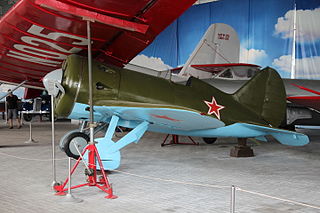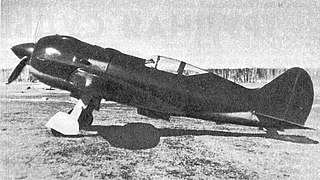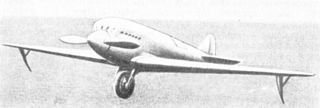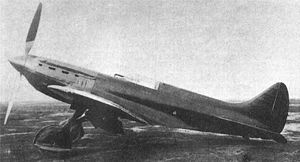
The Polikarpov I-16 is a Soviet single-engine single-seat fighter aircraft of revolutionary design; it was the world's first low-wing cantilever monoplane fighter with retractable landing gear to attain operational status and as such "introduced a new vogue in fighter design". The I-16 was introduced in the mid-1930s and formed the backbone of the Soviet Air Force at the beginning of World War II. The diminutive fighter, nicknamed "Ishak" or "Ishachok" by Soviet pilots, figured prominently in the Second Sino-Japanese War, the Battle of Khalkhin Gol, Winter War and the Spanish Civil War – where it was called the Rata ("rat") by the Nationalists or Mosca ("fly") by the Republicans. The Finns called the aircraft as Siipiorava "(flying squirrel)".

The Tupolev ANT-40, also known by its service name Tupolev SB and development co-name TsAGI-40, was a high speed twin-engined three-seat monoplane bomber, first flown in 1934. The Tupolev design was advanced but lacked refinement, much to the dismay of crews, maintenance personnel, and Stalin, who pointed out that "there are no trivialities in aviation".

The Polikarpov I-185 was a Soviet fighter aircraft designed in 1940. It was flown with three engines but all of them were either insufficiently developed for service use or their full production was reserved for other fighters already in production. The I-185 program was cancelled on 27 January 1943.

Grigorovich M-15 was a successful Russian World War I-era biplane flying boat, developed from the M-9 by Grigorovich.

The ANF Les Mureaux 110 and its derivatives were a family of French reconnaissance aircraft developed in the 1930s. They were all-metal, parasol-wing monoplanes that seated the pilot and observer in tandem open cockpits. The aircraft were widely used in the Battle of France, but were all scrapped soon thereafter.

The Avia B-34 was a biplane fighter aircraft built in Czechoslovakia in the early 1930s. It was the first design of František Novotný for the Avia company and although built only in small numbers, it paved the way for the Avia B-534.

The Klimov M-103 is a V12 liquid-cooled piston aircraft engine used by Soviet aircraft during World War II.
The Renard Epervier was a Belgian prototype single-seat all-metal fighter monoplane designed by Alfred Renard at the Societé Anonyme Avions et Moteurs Renard for a government-sponsored design contest in 1928. The Epervier Type 2 was built and flown in 1928, by Belgian aircraft manufacturer Stampe et Vertongen. It carried an armament of two synchronised 7.7mm guns and was lost in September 1928 after failing to recover from a flat spin. A second prototype, the Epervier Type 2bis, introduced revised streamlined fairings for the cantilever mainwheel legs, mainwheel spats and cylinder aft-fairings and was built by SABCA.

The Potez 39 was a French two-seat single-engined parasol wing monoplane reconnaissance and observation aircraft of the 1930s.
The Ilyushin I-21,, also known as TsKB-32, was a single-engined, single-seat fighter produced in the USSR in 1936-7 in response to a government specification.

The Bartini Stal-6, was a single-engined experimental aircraft designed, built and tested in the USSR from 1930.

The Pashinin I-21 was an early 1940s Soviet fighter prototype. Designed by Mikhail M. Pashinin, the I-21 was built to incorporate lessons learned from the combat experiences of Soviet pilots during the Spanish Civil War and the Nomonhan Incident with the Empire of Japan. Despite showing promising performance, the I-21 did not get past the prototype stage, as it was felt the type did not offer a significant enough increase in capability over competitors already in production, such as the Yakovlev Yak-1 or Mikoyan Gurevich MiG-3.
The Bréguet 482 was a French four-engined heavy bomber aircraft designed just prior to the outbreak of the Second World War with two prototypes nearing completion when Germany invaded France in 1940, one of which was flown after the end of the war as an experimental platform.

The Tupolev I-14 was a Soviet fighter aircraft of the 1930s. It was a single-engined, single-seat monoplane with retractable undercarriage, designed to carry heavy armament, and as such was one of the most advanced fighters of its time. It was ordered into production, but this was cancelled after only a small number had been built, the competing Polikarpov I-16 being preferred.

The Vickers F.B.16 was a British single-seat fighter aircraft of the First World War. It was originally designed to be powered by an experimental radial engine, development of which was abandoned. When re-engined with more powerful and reliable water-cooled V-8 engines, the F.B.16 demonstrated good performance, but only a few prototypes were built, the type not entering service.
The Vickers F.B.24 was a British two-seat fighter aircraft of the First World War. Only a few prototypes were built, as, although it had good performance, the Bristol F.2 Fighter was preferred.

The Vickers F.B.25 was a British two-seat night fighter prototype of World War I designed to attack enemy airships. Completed in 1917, it failed in its official flight tests that year and no order for production resulted.

The Bernard 82 was a French single-engined long-range monoplane bomber designed and built by Société des Avions Bernard. Only two prototypes were built and the type did not enter production.
The Tupolev ANT-29 was a 1930s twin-engined, cannon-armed fighter designed by Alexander Arkhangelsky and built by Tupolev.

P.Z.L. P.8 was a fighter designed by Ing. Zygmunt Puławski and constructed by P.Z.L. from 1930.















